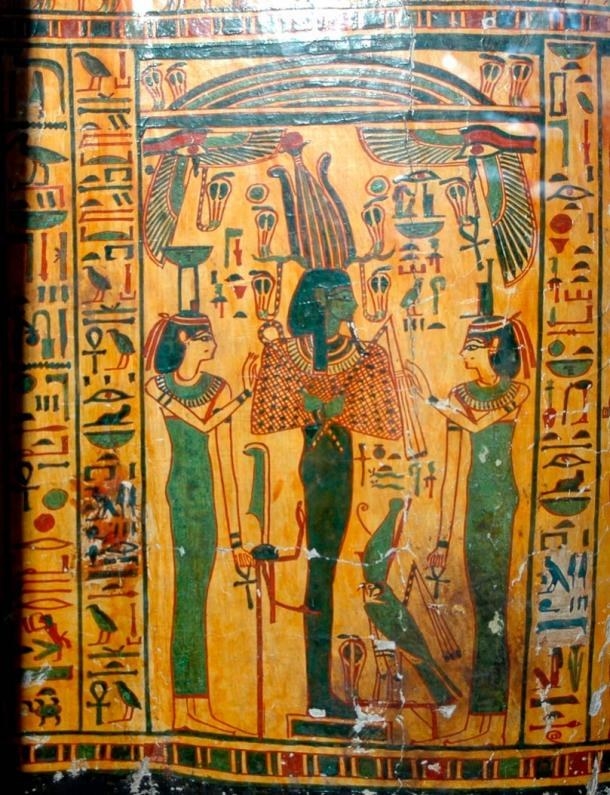
The rest of the story centers on Horus, he is the product of Isis and Osiris union, who is initially a susceptible child secluded by the mother and then turned into a foe of Set for the throne. The frequent violent conflict ended with Horus's success, which returns Maat (the cosmic and the social order) into Egypt after the unrighteous reign of Set and completed the resurrection process of Osiris.
Images of Osiris
Osiris as the living god described him as the handsome man in a royal dress in the crown of the Upper Egypt as plumed headdress called as Atef while holding the crook and the flail, these are the symbols of kingship and Osiris’s main role is the Judge’s of the Dead. Osiris’s was also identified being the King of the alive, Lord of Love, and the Eternal Lord. After god Isis, Osiris became the famous and the lasting of all the gods in Egypt. His worship extended thousands of years, starting before the known Early Dynastic Period up to this Ptolemaic Dynasty, which is believed to be the final dynasty to rule the Egypt before the appearance of Rome.

Sometimes the Egyptians denied Osiris’s death, although the traditions bulk, about his death makes it obvious that he was murdered. In some instances the story suggests that Set transformed in the form of an animal, such as the wild bull or crocodile to slay Osiris; then, in the other story they implied that Osiris's body is being thrown or drowned in the water. This latter ritual is the source of the Egyptian faith that the people who had been drowned in the water of Nile were sacred, and even the personality of the victim has been changed, as it is occasionally the god Haroeris, the elder figure of Horus, who had been killed by Set and avenged by the other figure of Horus, who’s Haroeris's son through Isis.
Through the New Kingdom’s end, a tradition had widened that Osiris's body had cut by Set into pieces and spread them across Egypt. The cult concentrates of Osiris all through the country asserts that the body or certain pieces of it, had been located near them. The cut parts were said to be a total of forty-two, and each piece being connected with the forty-two provinces or nomes in Egypt. Therefore, the kingship god becomes the personification of his kingdom.
Osiris death and resurrection
Osiris rules Egypt and having innate the kingship from the ancestors in the lineage reaching back to the maker of the world, Atum or Ra. Isis is his queen, who, together with Osiris and Set, his murderer, is one of the offspring of the world god Geb and Nut, the sky goddess. Osiris is associated with the righteous kingship, life-giving power, and the law of maat, the idyllic natural order whose upholding was a fundamental aim in the ancient Egyptian civilization. Set is closely connected with chaos and violence. Thus, the killing of Osiris represents the struggle between the order and the disorder, and the interruption of life through death.
According to the spell in a Pyramid Text, Set is getting vengeance for a kick that Osiris gave him, but in the Late Period texts, the grievance of Set is because Osiris had a union with Nephthys, who happened to be Set's wife and also Geb and Nut’s fourth child. The killing itself is never clearly explained.
Sometimes the Egyptians denied Osiris’s death, although the traditions bulk, about his death makes it obvious that he was murdered. In some instances the story suggests that Set transformed in the form of an animal, such as the wild bull or crocodile to slay Osiris; then, in the other story they implied that Osiris's body is being thrown or drowned in the water. This latter ritual is the source of the Egyptian faith that the people who had been drowned in the water of Nile were sacred, and even the personality of the victim has been changed, as it is occasionally the god Haroeris, the elder figure of Horus, who had been killed by Set and avenged by the other figure of Horus, who’s Haroeris's son through Isis.
Through the New Kingdom’s end, a tradition had widened that Osiris's body had cut by Set into pieces and spread them across Egypt. The cult concentrates of Osiris all through the country asserts that the body or certain pieces of it, had been located near them. The cut parts were said to be a total of forty-two, and each piece being connected with the forty-two provinces or nomes in Egypt. Therefore, the kingship god becomes the personification of his kingdom.
Osiris funerary ritual


